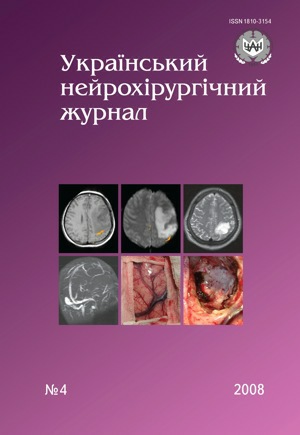Immediate and long-term results of cauda equine ependimomas surgical treatment
DOI:
https://doi.org/10.25305/unj.108385Keywords:
термінальний відділ спинного мозку, епендимоми, хірургічне лікування.Abstract
Results of investigation and surgical treatment at 74 patients with cauda equine ependimomas, operated during 1988–2007 years, are analyzed. All tumors were intradural. According to their localization the tumors are divided on: cauda equine ependimomas, growing from terminal part of a spinal cord and extended among cauda equine; cauda equine ependimomas, primarily located among cauda equine roots and more often arised on filum terminale. Tumors were removed totally at 64,86% patients, subtotally — at 31,08%, partially — at 2,7%. Frequency of relapses was 12%, of continued growth — 9%.
References
Евзиков Г.Ю., Фомичев В.Г. Хирургическое лечение интрадуральных экстрамедуллярных спинальных опухолей // Нейрохирургия. — 2004. — №2. — С.3–7.
Akyurek S., Chang E.L., Yu T.K. et al. Spinal myxopapillary ependymoma outcomes in patients treated with surgery and radiotherapy at M.D. Anderson Cancer Center // J. Neurooncol. — 2006. — P.177–183.
Cihangiroglu M., Hartker F.W., Lee M. еt al. Intraosseous sacral myxopapillary ependymoma and the differential diagnosis of sacral tumors // J. Neuroimag. — 2001. — V.11. — P.330–332.
Fassett D.R., Schmidt M.H. Lumbosacral ependymomas: a review of the management of intradural and extradural tumors // Neurosurg. Focus. — 2003. — V.15, N5. — Art.13.
The WHO Classification of Tumours of the Central Nervous System. — 4th еd. G.N. Fuller // Arch. Pathol. Lab. Med. — 2008. — V.132. — P.906.
Kocak Z., Garipagaoglu M., Adli M. et al. Spinal cord ependymomas in adults: Analysis of 15 cases // J. Exp. Clin. Cancer Res. — 2004. — V.23, N2. — P.201–206.
Merchant T.E., Fouladi M. Ependymoma: new therapeutic approaches including radiation and chemotherapy // J. Neuro-Oncol. — 2005. — V.75. — P.287–299.
Ming-Tak Ho D., Hsu C., Wong T., Chiang H. A clinicopathologic study of 81 patients with ependymomas and proposal of diagnostic criteria for anaplastic ependymoma // J. Neuro-Oncol. — 2001. — V.54. — P.77–85.
Nakama S., Higashi T., Kimura A. et al. Double myxopapillary ependymoma of the cauda equina // J. Orthop. Sci. — 2005. — V.10. — P.543–545.
Rickert C.H., Kedziora O., Gullotta F. Ependymoma of the cauda equina // Acta Neurochir. — 1999. — V.141. — P.781–782.
Turgut M., Ak H., Ozkara E. Filum terminale ependymoma with intratumoral and spinal subarachnoid hemorrhage // Surg. Neurol. — 2006. — V.66. — P.646–647.
Wager M., Lapierre F., Blanc J.L. et al. Cauda equina tumors: a French multicenter retrospective review of 231 adult cases and review of the literature // Neurosurg. Rev. — 2000. — V.23. — P.119–129.
Downloads
Published
How to Cite
Issue
Section
License
Copyright (c) 2008 E. I. Slynko, A. G. Karleichuk

This work is licensed under a Creative Commons Attribution 4.0 International License.
Ukrainian Neurosurgical Journal abides by the CREATIVE COMMONS copyright rights and permissions for open access journals.
Authors, who are published in this Journal, agree to the following conditions:
1. The authors reserve the right to authorship of the work and pass the first publication right of this work to the Journal under the terms of Creative Commons Attribution License, which allows others to freely distribute the published research with the obligatory reference to the authors of the original work and the first publication of the work in this Journal.
2. The authors have the right to conclude separate supplement agreements that relate to non-exclusive work distribution in the form of which it has been published by the Journal (for example, to upload the work to the online storage of the Journal or publish it as part of a monograph), provided that the reference to the first publication of the work in this Journal is included.









